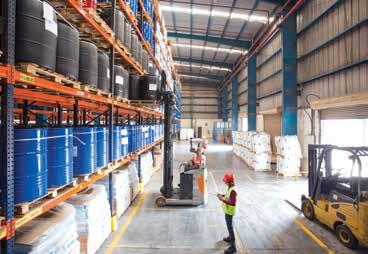
6 minute read
C V Kumar, CEO , CCI Logistics
c v kumar
While shippers have been facing a ‘triple shock’ from the coronavirus outbreak that looks set to continue for some time yet, logistics service providers have been equally impacted by the ‘dangerous combination’ of transport capacity shortages, disruptions to supply chains and an inability to plan. As the government starts to lift the lockdown in phases, the number of trucks plying on the road is increasing but fleet owners say the big challenge is convincing drivers to return to work.
Advertisement
C V Ku mar , CEO, CCI Logist ics Limite d
informs Upamanyu Borah, more on the ground reality which is continually in flux, and how the company is trying to adapt to the changing environment.
In the fifth phase of lockdown or phase-I of unlock 1.0, what is the ground reality? Has the transport been restored to any extent? Transportation is the one thing that connects all stages of the supply chain, from farm to food processing to warehouse to grocery store. A shortage of truck driv ers, is posing a serious threat to the entire supply chain as the high demand for essential services continue unabated.
At present, only 25-35 per cent of the trucks are on road due to driver unavail ability. Additionally, there’s enormous pressure on logistics service providers (LSPs), and non-placement of vehicles has become a bane. Export-Import (EXIM) cargo movement is also hit due to low trailer availability.
In container freight stations (CFSs), due to low number of Kalmar operators, loading and unloading of both stuffed and empty containers are running slow. Also, other stakeholders and service providers in the export-import (EXIM) containerised trade are either not func tioning or functioning marginally because of uncertainties related to the current environment.
However, things are turning to change now. Importers and agencies involved in import clearance/transporta tion are starting to take delivery of import loaded containers. Besides, essential labour is being deployed by CFSs to handle the export-related work.
Please inform us about the ongoing situation with shippers. There is a growing frustration among the shippers because the coronavirusled lockdown has pushed things back ward. They are facing potential threats to their business with less manpower in production/packaging/loading and un loading operations. They are also having a hard time finding drivers and truck capacity.
More than 60 per cent of India’s (or ganised long haul) trucking fleet is now without drivers, the logistics sector may not see an immediate uptick since most drivers have gone back to their native places. When the volume rebound hap pens, it will get harder for shippers without capacity guarantees to get enough truck space.
I believe, in the current unpredictable situation, shippers need to react fast to market and industry changes and consider short-term arrangements rather than long-term commitments. Like us, they will need a lot of energy, good data…and some luck to tackle the ongo ing challenges of the coronavirus, however long the crisis lasts.
There was an appeal made by logistics service providers for clearing dues and making 100 per cent advance payment, recently. How has shippers reacted to it? An appeal has been made. But, we also have to understand that anything be yond the limit, be it request for making advance payments; will be just impos sible for everyone at the moment. Most of the shippers have agreed to clear pending payments while some have as sured for partial advance.
Nonetheless, to make a change in the modus operandi in a highly fragmented industry is a difficult task besides being time-consuming.
Is this the right time for modal shift from road to rail? Road and rail are like chalk and cheese, entirely different and catering to differ ent product segments.
We do not see a large shift from road to rail at this stage. In fact, large scale multimodal shift has not taken place as anticipated earlier. Probably, there are better chances for RORO operations, which will be a win-win for all.
The consumer sentiment being low now and considering economic downturn across the globe, what will be the scenario of warehousing requirement in the country in the next couple of years? Sentiments might be weak globally, but Indian domestic market would remain robust. However, for the next six months, it will see a dip due to the pandemic.
Warehousing demand would con tinue to boom and the long-term prospects for warehousing is still very bright in India considering an expected in crease in domestic demand and possibility of global firms shifting manufacturing to India to de-risk supply chains. The segment is also expected to attract a large pool of capital with fund managers looking at warehousing and industrial real estate as a safer, resilient and scalable asset class for their investors.
St rong compa n ie s with good processes and financial resources will emerge stronger. It will take another 5-6 years for the Indian industry to shift to modern warehous ing from their traditional stocking points and till then the demand sce nario is rosy.
Experts say the industry will also see lot of automation into warehouses with less staff and more of machines doing the job. Is this a curious case of commercial consideration or a business continuity necessity? Automation in warehousing is inevitable and COVID-19 has only accelerated the need for automation. Post-lockdown, for warehouse operators and logistics companies, distribution, manufacturing and supply chain processes are about to change very quickly.
As warehouses have become large in size, automation in picking has become a necessity than a luxury. These days, warehouses have a very large through put, and only automation makes it possible to run efficiently. It’s seen as a combination of both commercial requirement and business continuity.
While it’s certainly true that things like automation and robotics can save a company sizable amounts of cash, one has got to be willing to heavily invest first. The downside is that much of the technology on the hardware side is still fairly expensive to install and integrate.

How is CCI Logistics operating in the work-from-home scenario? Are you able to provide a good shipping experience during the lockdown? CCI Logistics has successfully managed and still assisting and meeting client’s needs under the work-fromhome scenario.
Our esteemed customers have been very understanding and have accepted electronic submission of documents such as eDockets as well as paperless invoicing and crediting options like eBilling and ePODs. Hence, by and large, our opera tions are running smooth.
However, as I mentioned earlier, due to unavailability of drivers, we are not able to fully deploy or operate ve hicles for our customers as they had asked. Well, this has become a chal lenge for almost all LSPs and not just in our case.
Post-lockdown how long would you estimate it would take for our industry to get back to business as usual? Are the drivers coming back anytime soon and normalcy be restored? All kinds of working hands have left the cities. Though few many drivers have started trickling back to work, our estimate is that majority of them would return to work only after the monsoon season. Now, that will be around the end of August or begin ning of September.
Till then, vehicle shortage will be a reality. We have another two to three months of uncertainty to forecast and manage.
Initial estimates were that sectors like transportation, storage, warehous ing would come back quickly as restrictions relax but since most drivers and the ground workforce have gone back to where they belong; it will take a little longer for the sector to bounce back.










